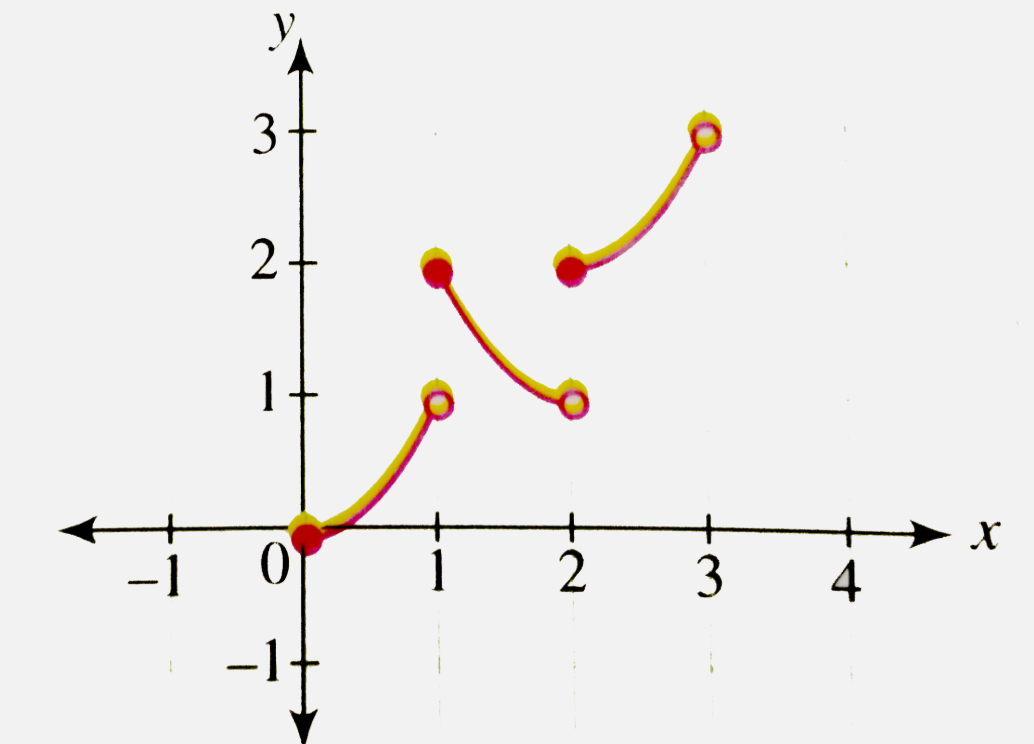The range of function y=[x2]=[x]2,x∈[0,2] (where [.] denotes the greatest function), is {0} b. {0,1} c. {1,2} d. {0,1,2}Solution in Tamil
[0]
[0,1]
[1,2]
[0,1,2]
The correct Answer is:D
We have,
y=[x2]−[x]2,x∈[0,2]i.e.,y=[x2],0≤x<1y=[x2]−1,1≤x<2y=0x=2i.e.,y=0,0≤x<1=1−1=0,1≤x<√2=2−1=1,√2≤x<√3=3−1=2,√2≤x<√3=3−1=2,√3≤x<2=0x=2
Hence, the range is {0,1,2}.
Topper's Solved these Questions
- BOOK - CENGAGECHAPTER - FUNCTIONSEXERCISE - Multiple Correct Answers Type10videos
FUNCTIONS
- BOOK - CENGAGECHAPTER - FUNCTIONSEXERCISE - Comprehension Type7videos
FUNCTIONS
- BOOK - CENGAGECHAPTER - EQUATION OF PLANE AND ITS APPLICATIONS -IIEXERCISE - DPP 3.418videos
EQUATION OF PLANE AND ITS APPLICATIONS -II
- BOOK - CENGAGECHAPTER - GETTING STARTED WITH GRAPHSEXERCISE - Exercise18videos
GETTING STARTED WITH GRAPHS
Similar Questions
The function f(x)=cos−1⎛⎝2[|sinx|+|cosx|]sin2x+2sinx+114⎞⎠ is defined if x belongs to (where [.] represents the greatest integer function)
02:08View SolutionLet f(x)=x2−2x−1∀x∈R Let f:(−∞,a]→[b,∞), where a is the largest real number for which f(x) is bijective. If f:R→R , g(x)=f(x)+3x−1 , then the least value of function y=g(|x|) is
03:16View SolutionLet A(0,6,6), B(6,6,0) and C(6,0,6) are three points and point D is moving on the line x+z−3=0=y. If G is centroid of ΔABC, then minimum value of GD is
05:05View SolutionDoes the following graph pass the vertical or horizontal line test ?
 05:58View Solution
05:58View SolutionThe function y=sqrt(2x-x^(2))(A) increases in (0,2)(B) increases in (0,1) but decreases in (1,2)(C) Decreases in (0,2) (D) Increases in (1,2) but decreases in (0,1)
02:42View SolutionThe range of f(x)=[|sinx|+∣cosx|]. Where [.] denotes the greatest integer function, is {0} (b) {0,1} (c) {1} (d) none of these
01:51View SolutionThe range of function y=[x2]=[x]2,x∈[0,2] (where [.] denotes the greatest function), is {0} b. {0,1} c. {1,2} d. {0,1,2}
03:33View SolutionThe range of the function y=[x^(2)]-[x]^(2)x in[0,2] (where [] denotes the greatest integer function),is
06:22View SolutionLet f''(x)>0 and ϕ(x)=f(x)+f(2−x),x∈(0,2) be a function then the function ϕ(x) is (A) increasing in (0,1) and decreasing (1,2) (B) decreasing in (0, 1) and increasing (1,2) (C) increasing in (0, 2) (D) decreasing in (0,2)
03:53View SolutionThe range of the function f(x)=2+x−[x−3] is, (where [.] denotes greatest integer function):
01:33View SolutionIf limx→0√ln(cos(x2+[|a−1|]))=0 (where [.] is greatest integer function) then range of a contains
(A) [1,2)
(B) (0,2)
(C) (0,1]
(D) [0,3)02:26View SolutionThe range of the function y=2sin−1[x2+12]+cos−1[x2−12] is (where, [.] denotes the greatest integer function)
03:10View SolutionThe range of function f(x)=[[x]−x]+sin2x, where [.] denotes the greatest integer function, is.
01:55View SolutionThe range of the function f(x)=sin(π[x])x2+1 (Where [ ] denotes greatest integer function) is
(A) {0}
(B) (−∞,∞)
(C) (0,1)
(D) R−{0}02:32View SolutionThe range of f(x)=[|sinx|+∣cosx|]. Where [.] denotes the greatest integer function, is {0} (b) {0,1} (c) {1} (d) none of these
02:17View SolutionThe range of the function y=[x2]−[x]2 x∈[0,2] (where [] denotes the greatest integer function), is
02:10View Solution

